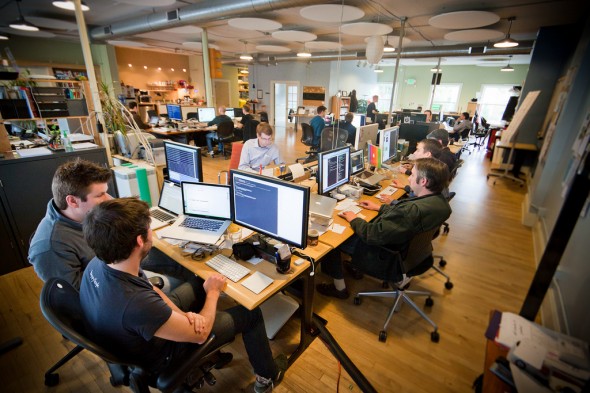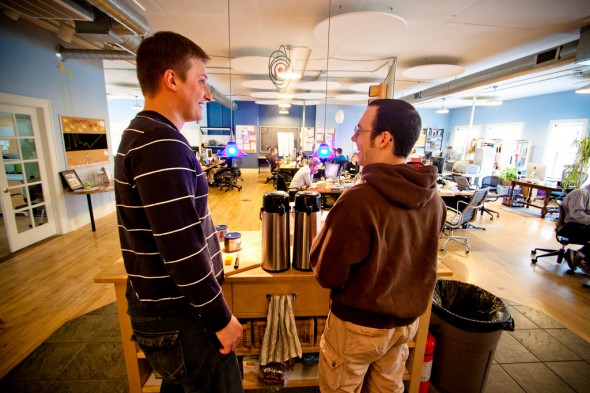I’m a workplace designer by professional experience and education. As Atomic Object’s multi-tasking business manager, one of the many hats I wear is as its workplace planner and designer. Before joining Atomic Object, I researched and designed leading edge workplaces for Herman Miller.
The Harvard Business Review is not my typical go-to source for insights into matters of physical work space, but this article landed squarely at the intersection of my interests in workplace culture and workplace design:
Who Moved My Cube? by Anne-Laure Fayard and John Weeks.
At Atomic, we research and test usability as we design software. This article made me ponder usability from a workplace design perspective.
The Idea in Brief
Casual interactions among employees promote trust, cooperation, and innovation, and companies have devised open floor plans and common areas to encourage them. But such efforts can easily backfire.
Common sense, it turns out, is a poor guide when it comes to designing for interaction. Take the growing enthusiasm for replacing private offices with open floor plans in order to encourage community and collaboration. More than a dozen studies have examined the behavioral effects of such redesigns. There’s some evidence that removing physical barriers and bringing people closer to one another does promote casual interactions. But there’s a roughly equal amount of evidence that because open spaces reduce privacy, they don’t foster informal exchanges and may actually inhibit them. Some studies show that employees in open-plan spaces, knowing that they may be overheard or interrupted, have shorter and more-superficial discussions than they otherwise would.
Both sets of findings are correct. Open floor plans, or indeed any type of design, can either encourage or discourage informal interactions, depending on a complex interplay of physical and social cues.
Spaces, whether physical or virtual, invite interaction only if they properly balance three factors, or “affordances.”
The concept of “affordances,” developed by the psychologist James Gibson, explains how an object or an environment communicates its purpose and offers possibilities for action. Handles afford grasping; doors afford entry and exit; paths afford locomotion.
Affordance theory helps us understand how the design of an object might affect the ways people use it. An object generally gets its intended use only when the design exposes its purpose. There are myriad examples of bad designs that obscure affordances, from door handles whose shape gives no indication whether they should be pushed or pulled to aesthetically impressive control panels consisting of identical knobs symmetrically arrayed, without any visual clues as to what the various knobs do. In such cases conscious thought, and sometimes even training, is needed before people can understand and make use of an object’s functions.
The three affordances linked to successful interactive workplaces:
Proximity
Designs must drive traffic to shared spaces and give people reasons to remain. Centrally located areas containing shared resources such as photocopiers and coffee machines do this well. For virtual workers, continuously open video links and instant messaging provide a sense of proximity.Privacy
People must feel confident that they can converse without being interrupted or overheard. They must also be able to avoid interacting when they want to. Alcoves lend privacy to public spaces. Clear policies about who has access to which communications help protect privacy online.Permission
Company leadership and culture, as well as the space itself, must convey that casual conversation is encouraged. Comfortable furniture and obviously work-related machines such as photocopiers help send that signal. In addition, leaders should model desired behaviors in both physical and virtual spaces.
 Atomic’s open, interactive workplace is constantly evolving, enabling our growth and business activity. Now, I have a broader perspective on the physical and social cues needed to support interaction. I will post my progress and any innovations on our blog. Stay tuned. Some workplace affordances are more obvious than others. Meanwhile, consider the cues of smelling freshly popped popcorn: Scoop. Enjoy.
Atomic’s open, interactive workplace is constantly evolving, enabling our growth and business activity. Now, I have a broader perspective on the physical and social cues needed to support interaction. I will post my progress and any innovations on our blog. Stay tuned. Some workplace affordances are more obvious than others. Meanwhile, consider the cues of smelling freshly popped popcorn: Scoop. Enjoy.


